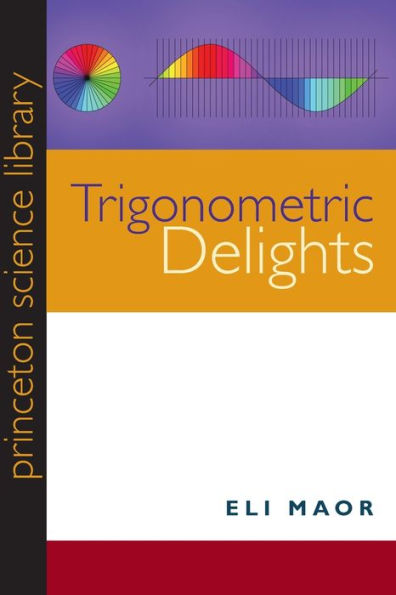

Paperback(Reissue)
-
PICK UP IN STORECheck Availability at Nearby Stores
Available within 2 business hours
Related collections and offers
Overview
Maor, whose previous books have demystified the concept of infinity and the unusual number "e," begins by examining the "proto-trigonometry" of the Egyptian pyramid builders. He shows how Greek astronomers developed the first true trigonometry. He traces the slow emergence of modern, analytical trigonometry, recounting its colorful origins in Renaissance Europe's quest for more accurate artillery, more precise clocks, and more pleasing musical instruments. Along the way, we see trigonometry at work in, for example, the struggle of the famous mapmaker Gerardus Mercator to represent the curved earth on a flat sheet of paper; we see how M. C. Escher used geometric progressions in his art; and we learn how the toy Spirograph uses epicycles and hypocycles.
Maor also sketches the lives of some of the intriguing figures who have shaped four thousand years of trigonometric history. We meet, for instance, the Renaissance scholar Regiomontanus, who is rumored to have been poisoned for insulting a colleague, and Maria Agnesi, an eighteenth-century Italian genius who gave up mathematics to work with the poor—but not before she investigated a special curve that, due to mistranslation, bears the unfortunate name "the witch of Agnesi." The book is richly illustrated, including rare prints from the author's own collection. Trigonometric Delights will change forever our view of a once dreaded subject.

Product Details
| ISBN-13: | 9780691158204 |
|---|---|
| Publisher: | Princeton University Press |
| Publication date: | 02/24/2013 |
| Series: | Princeton Science Library , #29 |
| Edition description: | Reissue |
| Pages: | 256 |
| Product dimensions: | 6.00(w) x 9.10(h) x 0.80(d) |
About the Author
Table of Contents
Preface xi
Prologue: Ahmes the Scribe, 1650 B.C. 3
Recreational Mathematics in Ancient Egypt 11
1. Angles 15
2. Chords 20
Plimpton 322: The Earliest Trigonometric Table? 30
3. Six Functions Come of Age 35
Johann Müller, alias Regiomontanus 41
4. Trigonometry Becomes Analytic 50
Francois Viète 56
5. Measuring Heaven and Earth 63
Abraham De Moivre 80
6. Two Theorems from Geometry 87
7. Epicycloids and Hypocycloids 95
Maria Agnesi and Her "Witch" 108
8. Variations on a Theme by Gauss 112
9. Had Zeno Only Known This! 117
10. (sin x)/x 129
11. A Remarkable Formula 139
Jules Lissajous and His Figures 145
12. tan x 150
13. A Mapmaker's Paradise 165
14. sin x = 2: Imaginary Trigonometry 181
Edmund Landau: The Master Rigorist 192
15. Fourier's Theorem 198
Appendixes 211
1. Let's Revive an Old Idea 213
2. Barrow's Integration of sec ø 218
3. Some Trigonometric Gems 220
4. Some Special Values of sin α 222
Bibliography 225
Credits for Illustrations 229
Index 231
What People are Saying About This
[Maor] writes enthusiastically and engagingly. . . . Delightful reading from cover to cover. Trigonometric Delights is a welcome addition.
— Sean Bradley, Mathematical Association of America
If you think trigonometry has no more surprises for you, read Trigonometric Delights. Eli Maor will change your mind. The book presents the subject and its history the way they should be presented—it's a delight to read.
— Paul J. Nahin, author of "Duelling Idiots and Other Probability Puzzlers"
"If you always wanted to know where trigonometry came from, and what it's good for, you'll find plenty here to enlighten you."—Ian Stewart, New Scientist"Trigonometric Delights should be required reading for everyone who teaches trigonometry and can be highly recommended for anyone who uses it."—George H. Swift, American Mathematics Monthly"[Maor] writes enthusiastically and engagingly. . . . Delightful reading from cover to cover."—Sean Bradley, MAA Online"This book is full of interesting historical accounts about the development of mathematics."—Richard S. Kitchen, Mathematics Teacher
Maor eases the reader from the mathematical puzzles of the Rhind Papyrus all the way to infinite series and the analysis of music produced by vibrating strings. Along the course, he leads a grand tour of the lovely but often neglected area of mathematics called trigonometry.
— Jerry P. King, Professor of Mathematics at Lehigh University
This is a rich and challenging book that will appeal to mathematicians and should help attract a newer generation to the subject. By putting the history back into trigonometry, Maor tells the many stories of trigonometry, and shows that what is often regarded as a collection of dry techniques is really a marvelous testament to thousands of years of human ingenuity and intellectual creativity.
— Keith Devlin, author of "Mathematics: The Science of Patterns" and "Goodbye Descartes"
This book will appeal to a general audience interested in the history of mathematics. I highly recommend [it] to teachers who would like to ground their lessons in the sort of mathematical investigations that were undertaken throughout history.
— Richard S. Kitchen, Mathematics Teacher
Here is trigonometry viewed through the lens of history—a rich, intriguing book that will leave readers shouting for Maor.
— William Durham, author of "The Mathematical Universe".
